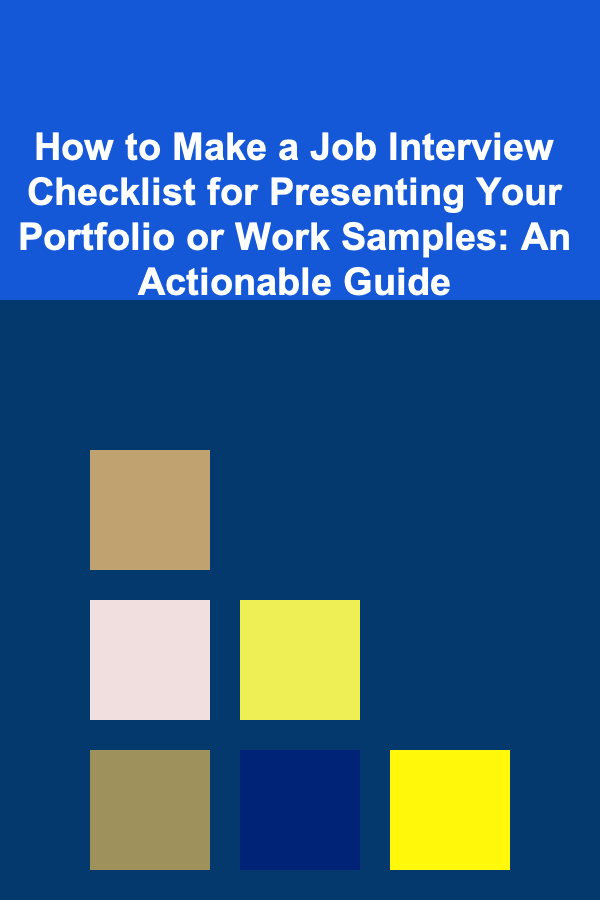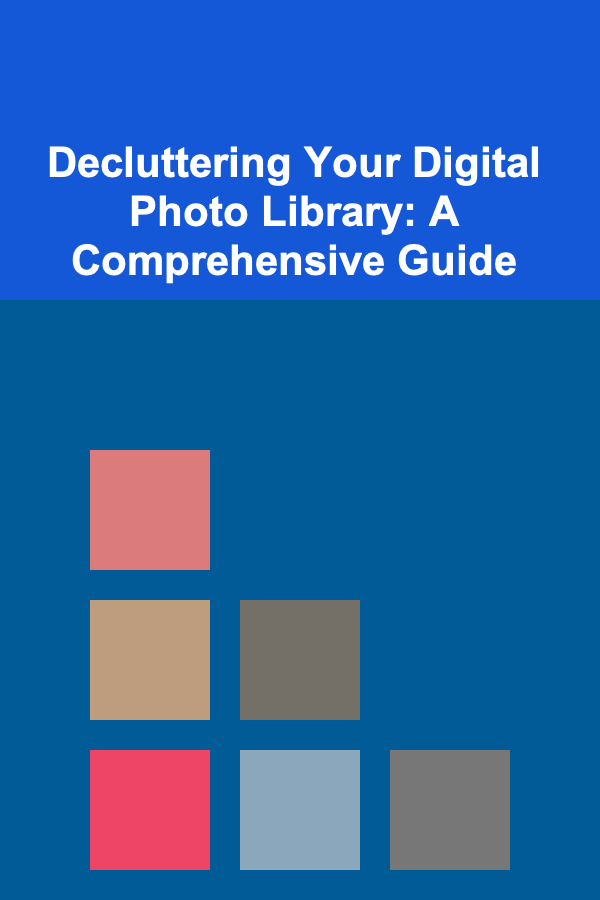
How to Make a Job Interview Checklist for Presenting Your Portfolio or Work Samples: An Actionable Guide
ebook include PDF & Audio bundle (Micro Guide)
$12.99$8.99
Limited Time Offer! Order within the next:

A job interview is often the most crucial stage of the hiring process, where your skills, qualifications, and potential are evaluated. One of the most powerful tools at your disposal is your portfolio or work samples, which showcase your expertise, creativity, and accomplishments. However, merely bringing a portfolio to an interview is not enough. To truly stand out and make a lasting impression, you need to present it effectively.
This actionable guide provides a comprehensive checklist to help you present your portfolio or work samples confidently and professionally during a job interview. By following these steps, you will ensure that you highlight your strengths and demonstrate why you're the best fit for the role.
Understand the Job Role and Company Expectations
Before you even start preparing your portfolio for the interview, it's essential to understand the job you're applying for and the company's expectations. A tailored approach to your portfolio will allow you to present the most relevant work and demonstrate how your experience aligns with the company's needs.
Step-by-Step Actions:
- Review the job description thoroughly: Identify key skills, qualifications, and responsibilities mentioned in the job posting. Highlight the aspects of your work that match these requirements.
- Research the company culture and industry: Explore the company's website, social media profiles, and industry trends to understand their values and the types of projects they engage in. This will help you choose work samples that resonate with the company's style and objectives.
- Identify the type of work the employer values: If you're applying for a design role, for example, they may prioritize visual aesthetics and creative thinking. For a software development position, they may focus on functionality and problem-solving skills.
Select the Best Work Samples for the Job
Your portfolio is a collection of your best work, but not all work samples are created equal. When selecting the pieces to showcase during your interview, focus on quality over quantity. It's better to present a few outstanding samples that demonstrate your skills and creativity than to overwhelm the interviewer with too many pieces.
Step-by-Step Actions:
- Choose work relevant to the role: Select pieces that best represent the skills required for the job you're applying for. For example, if you're interviewing for a marketing position, show campaigns you've worked on that demonstrate your ability to drive results.
- Show diversity: If possible, include a mix of work that showcases different skills or aspects of your expertise. For example, if you're a graphic designer, you could include both print and digital projects to show your versatility.
- Highlight your role in each project: Ensure that each piece you present includes context about your specific contributions. Clearly communicate what you did, how you approached the project, and the impact it had. This helps the interviewer understand your individual contributions and skills.
- Consider the medium: If the company's focus is on digital media, ensure that your portfolio contains samples that are relevant to that format. If the job involves a physical product or presentation, include tangible samples or photographs of your work.
Organize Your Portfolio for Easy Access
The way you present your portfolio matters just as much as the content itself. Disorganized portfolios can make it difficult for interviewers to focus on the quality of your work. Having a structured, easy-to-navigate portfolio will help you make a smooth and professional impression.
Step-by-Step Actions:
- Create clear sections or categories: Group your work into categories based on type, medium, or project type. This can be done digitally (with folders or links) or physically (with dividers or labels). Categories make it easier for the interviewer to follow your presentation and find relevant examples quickly.
- Consider the format: Whether you're presenting a digital portfolio on a laptop or tablet or using a physical portfolio, ensure it's well-organized and easy to flip through. If you're bringing a digital portfolio, make sure all files are working correctly and are easy to open.
- Prepare a portfolio for remote interviews: If the interview is virtual, ensure your portfolio is accessible and easy to share through platforms like Google Drive, Dropbox, or a personal website. Organize the content so that it can be quickly pulled up during the conversation.
- Include a brief introduction: When beginning your presentation, have a short introduction ready that highlights who you are, your background, and what the interviewer can expect to see in your portfolio. This sets the stage and provides context.
Prepare a Narrative Around Each Sample
Simply presenting work samples without any context can leave the interviewer guessing about your role and skills. To truly stand out, prepare a narrative that explains each piece, its purpose, and the value it brought to the project. This shows that you are reflective about your work and understand the impact of your contributions.
Step-by-Step Actions:
- Explain the context of each project: Briefly describe the client, the project goals, and the challenges you faced. This helps the interviewer understand the bigger picture and the relevance of your work.
- Highlight your role and contributions: Focus on your individual contributions. What specific skills did you apply? What was your process for solving problems? Show how you took ownership and contributed to the project's success.
- Demonstrate problem-solving and decision-making: Show that you can think critically about the work you've done. How did you overcome challenges? What decisions did you make to ensure the success of the project?
- Share the results or impact: Whenever possible, include measurable results (e.g., sales growth, increased engagement, customer satisfaction) to demonstrate the impact of your work. Concrete results will speak volumes about your abilities.
Be Ready for Technical or Detailed Questions
In some cases, interviewers will ask you in-depth questions about the specific tools, techniques, or processes you used to complete your work. Prepare yourself to answer these questions confidently.
Step-by-Step Actions:
- Review your work and the tools you used: Brush up on the software, technologies, and techniques you used for each project. Be ready to explain your choices and why you used them in specific situations.
- Prepare to discuss challenges: Interviewers may ask about difficult problems you encountered during the project. Think about challenges you faced and how you tackled them.
- Be honest about limitations: If a project didn't turn out exactly as you envisioned, don't be afraid to discuss what you learned from the experience. Employers appreciate candidates who can reflect on their work and grow from challenges.
Practice Your Presentation
An effective presentation isn't just about showing your work; it's about how you talk about it. Practice your narrative, so you can present your portfolio confidently and naturally.
Step-by-Step Actions:
- Rehearse your presentation: Practice explaining your work samples out loud. Focus on speaking clearly and confidently. Record yourself or present to a friend or family member to get feedback.
- Be concise but detailed: While you want to give enough detail to showcase your skills, avoid rambling. Keep your explanations concise, focusing on the most important elements of each project.
- Be prepared for questions: After each sample, the interviewer may ask follow-up questions. Be ready to answer them thoughtfully, and don't be afraid to ask for clarification if you're unsure about the question.
- Prepare for technical discussions: If you're in a technical field (e.g., programming, graphic design), you may be asked to dive deeper into the specific tools or techniques you used. Make sure you're familiar with the technical details of your work.
Have Backup Samples Ready
Sometimes, even the most carefully curated portfolio doesn't align perfectly with the job requirements or interviewers may request additional examples. Having extra samples on hand shows preparedness and flexibility.
Step-by-Step Actions:
- Bring additional work samples: Have a few extra projects available in case the interviewer asks for something more specific. These can be stored digitally or in a separate section of your physical portfolio.
- Bring a variety of work: If possible, bring a range of work, including side projects, personal projects, or volunteer work. This demonstrates your passion and versatility.
Conclusion
Presenting your portfolio or work samples during a job interview is a critical moment to demonstrate your abilities and make a strong impression. By following this actionable checklist, you can ensure that your portfolio is well-organized, your presentation is compelling, and you are fully prepared to answer any questions. Remember, your portfolio is more than just a collection of work---it's a reflection of your skills, creativity, and problem-solving abilities. By presenting it thoughtfully and confidently, you will show the interviewer not just what you can do, but why you're the perfect fit for the role.

How to Handle Seasonal Rental Property Trends and Adjust Rent Prices
Read More
How to Plan for Emergency Kit Needs During a Pandemic
Read More
The Ultimate Guide to Free Online Courses for Personal and Professional Growth
Read More
Decluttering Your Digital Photo Library: A Comprehensive Guide
Read More
How to Plan a Charity Gala That Raises Funds
Read More
How to Leverage Social Media for Nonprofit Advocacy
Read MoreOther Products

How to Handle Seasonal Rental Property Trends and Adjust Rent Prices
Read More
How to Plan for Emergency Kit Needs During a Pandemic
Read More
The Ultimate Guide to Free Online Courses for Personal and Professional Growth
Read More
Decluttering Your Digital Photo Library: A Comprehensive Guide
Read More
How to Plan a Charity Gala That Raises Funds
Read More